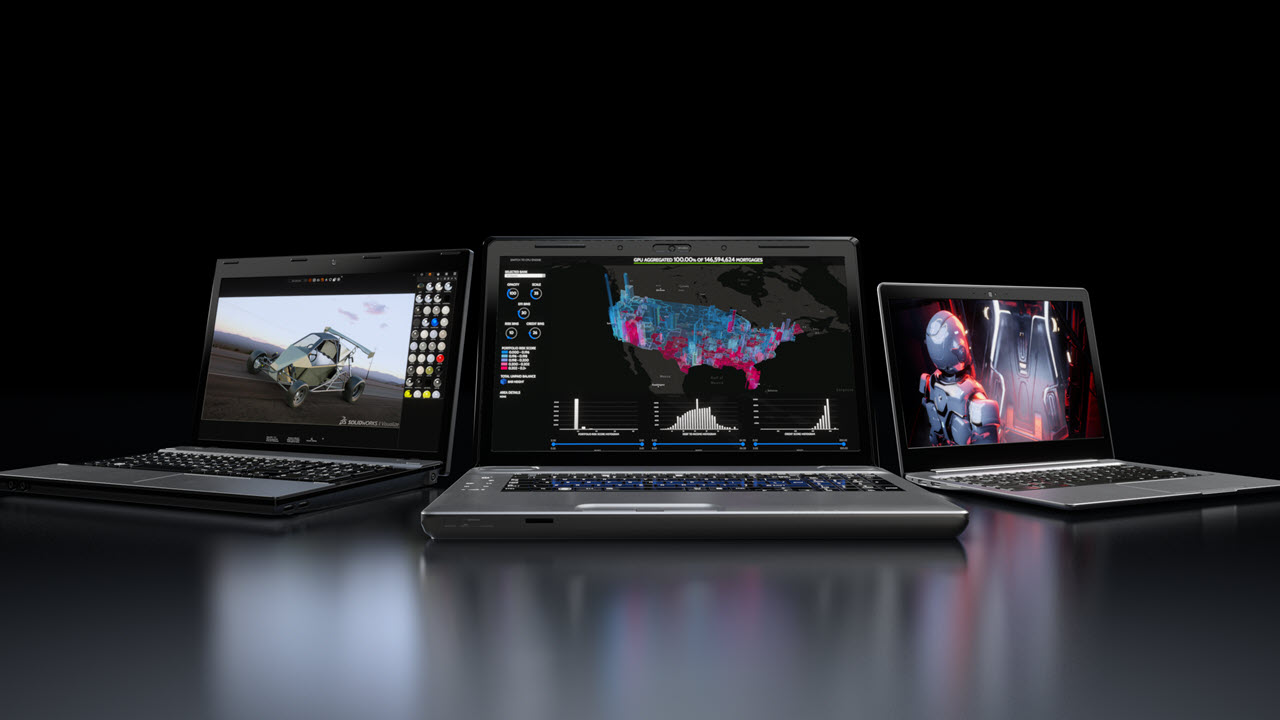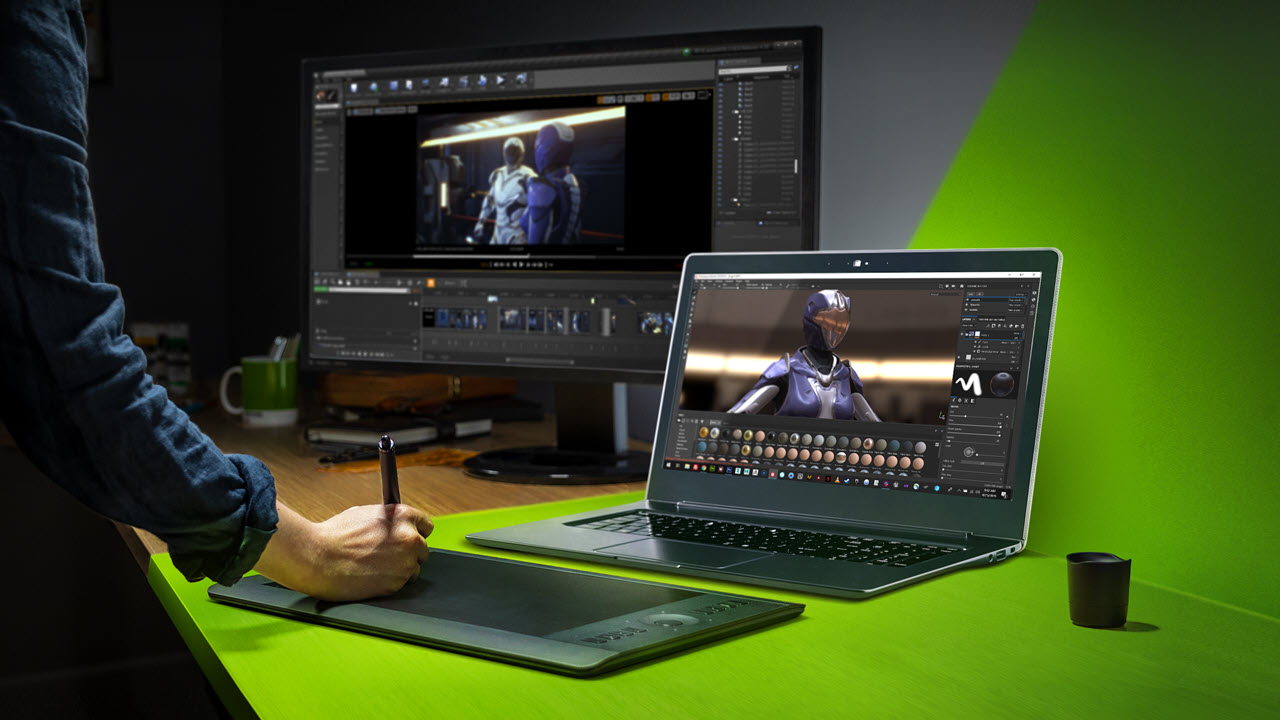Nvidia’s Mobile Quadro Family Gets Turing GPUs, Up To 16GB GDDR6
First introduced eight months ago, Nvidia’s Turing architecture has found its way into desktop GPUs, gaming laptops, workstation PCs, and general-purpose accelerators. Today’s announcement of the Quadro RTX 5000, 4000, 3000, Quadro T2000 and T1000 sees Turing stretch from top to bottom across the mobile workstation segment as well.
| Mobile Quadro Product Family | |||||||
| Row 1 - Cell 0 | RTX 5000 | RTX 4000 | RTX 3000 | T2000 | T1000 | P620 | P520 |
| Architecture (GPU) | Turing (TU104?) | Turing (TU104?) | Turing (TU106?) | Turing (TU117?) | Turing (TU117?) | Pascal (GP107?) | Pascal (GP107?) |
| CUDA Cores | 3,072 | 2,560 | 2,304 | 1,024 | 768 | 512 | 384 |
| Tensor Cores | 384 | 320 | 288 | N/A | N/A | N/A | N/A |
| RT Cores | 48 | 40 | 36 | N/A | N/A | N/A | N/A |
| Texture Units | 192 | 160 | 144 | 64 | 48 | 32 | 24 |
| Memory Capacity | 16GB GDDR6 | 8GB GDDR6 | 6GB GDDR6 | 4GB GDDR5 | 4GB GDDR5 | 4GB GDDR5 | 2GB GDDR5 |
| Memory Bus | 256-bit | 256-bit | 192-bit | 128-bit | 128-bit? | 128-bit? | 128-bit? |
| ROPs | 64 | 64 | 48 | 32 | 32? | 16 | 16 |
| L2 Cache | 4MB | 4MB | 3MB | 1MB | 1MB? | ? | ? |
| VR-Ready | Yes | Yes | Yes | No | No | No | No |
Conventional workloads naturally benefit from Turing’s most base advancements, including concurrent execution of floating-point and integer instructions, plus a reorganized cache hierarchy that makes more L1 and L2 memory available to the load/store units.
In addition to their higher CUDA core counts, the Quadro RTX models sport RT and Tensor cores. They also enjoy higher memory bandwidth thanks to GDDR6. The Txxxx- and Pxxx-series GPUs employ GDDR5 and lack RT/Tensor cores.
Digging deeper, parallels between Nvidia’s desktop GeForce RTX 20-series and GeForce GTX 16-series cards are clear.
The mobile Quadro RTX 5000 is presumably based on a fully enabled TU104 processor with 3,072 CUDA cores, 192 texture units, 64 ROPs, 48 RT cores, and 384 Tensor cores. Incidentally, those specifications mirror the Quadro RTX 5000 add-in card for workstations, including its 16GB of GDDR6 memory. But whereas the desktop board has a 200W power limit, mobile Quadro RTX 5000 will only be allowed a fraction of that, imposing tighter constraints on clock rates under load. For more detail on the design, check out Nvidia’s Turing Architecture Explored: Inside the GeForce RTX 2080.
At the Quadro RTX 4000 level, specs start diverging between the mobile and desktop solutions. The laptop-oriented version features 2,560 CUDA cores, 160 texture units, 64 ROPs, 40 RT cores, 320 Tensor cores, and 8GB of GDDR6 on a 256-bit bus. Meanwhile, the desktop RTX 4000 is limited to 2304 CUDA cores and all the other reduced resource counts that go along with its 36 Streaming Multiprocessors. Still, a 160W power limit gives the full-sized board headroom to compensate with significantly higher frequencies.
We’re guessing that the mobile Quadro RTX 3000 is based on TU106, similar to GeForce RTX 2070 and 2060. Like the former, it boasts 2,304 CUDA cores, 144 texture units, 36 RT cores, and 288 Tensor cores. But it’d appear to utilize the latter’s back-end, which is missing two ROP clusters. That cuts the ROP count to 48, the L2 cache to 3MB (from 4MB), and the memory bus to 192-bits, populated by 6GB of GDDR6 memory.
Get Tom's Hardware's best news and in-depth reviews, straight to your inbox.
Mobile Quadro RTX 5000, 4000, and 3000 are all considered to be VR-ready, offering enough performance to effectively drive modern HMDs. Quadro T2000 and 1000, not surprisingly, miss that cutoff.
Quadro T2000 would appear to be the first product based on a fully enabled TU117 GPU. Its 1,024 CUDA cores and 64 texture units correlate nicely with the chip’s 16 Streaming Multiprocessors split across two Graphics Processing Clusters. We also surmise that 4GB of GDDR5 memory means all four of Quadro T2000’s ROP partitions are active, yielding 32 total ROPs, 1MB of L2 cache, and a 128-bit memory bus. Of course, down at this level of performance, RT and Tensor cores aren’t as effective, so they’re excised from the architecture.
The same goes for Quadro T1000, which looks like TU117 with 12 of its Streaming Multiprocessors enabled. That’d give it 768 CUDA cores and 48 texture units. We’re not sure if the GPU retains its 32 ROPs and 128-bit memory bus. But it’s likely, given a similar complement of 4GB of GDDR5 memory.
Below the Turing-based mobile workstation GPUs, Nvidia is also adding Quadro P620 and P520, both based on the previous-gen Pascal architecture. These replace the existing entry-level Quadro P500 and P600 with higher CUDA core counts at each price point.
Pushing Ray Tracing and AI Into the Professional Space
Whereas gamers are bound to measure the success of Nvidia’s RTX initiative by the number of titles with compelling real-time ray tracing and DLSS effects, professional customers are more concerned with applications that affect their specific workflows. Nvidia is quick to point out its performance advantages in software already optimized for Quadro RTX cards, including Autodesk Arnold (global illumination rendering software), DaVinci Resolve 16 (a video/audio editing suite), Isotropix Clarisse iFX (a DCC and production renderer), and Substance Designer (a material authoring tool). But it’s also talking about a fairly substantial list of applications expected to incorporate optimizations for the Turing architecture “soon.” Enscape 3D, Adobe Lightroom, and SolidWorks Visualize are but a few on its list.
It remains to be seen how differently Nvidia’s mobile Quadro solutions perform compared to the desktop models. However, if your workflow in the office involves real-time ray tracing, AI, or denoising, and you’re already eyeballing RTX-optimized software, there’s a good chance that you’ll want similar functionality on the road. That’s where a mobile Quadro RTX might become relevant.
Nvidia Studio Addresses Integration and Support
Technologies like 3D Vision and G-Sync have demonstrated Nvidia’s propensity for controlling the ecosystems in which its products exist. So, rather than just launching this latest generation of mobile Quadro GPUs and letting platform partners handle integration, we’re not surprised to see the company announcing an initiative to certify laptops deemed capable of desktop-like performance. These RTX Studio systems will center on a mobile Quadro RTX 5000, 4000, 3000, GeForce RTX 2080, GeForce RTX 2070, or GeForce RTX 2060. They’ll also need a Core i7 H-series or better CPU, at least 16GB of RAM, a 512GB SSD or larger, and a 1080p or 4K display to qualify. The initial wave of RTX Studio laptops is expected in June starting at $1,600 from Acer, Asus, Dell, Gigabyte, HP, MSI and Razer.
RTX Studio laptops will ship with Studio drivers, which are specifically tested to ensure reliability in multi-app workflows utilizing software like Autodesk Maya 2019, 3ds Max 2020, Blackmagic Design DaVinci Resolve 16, and Daz3D Daz Studio. These drivers will support Quadro, Titan, and Turing/Pascal-based mobile GeForce GTX/RTX GPUs.
Nvidia says it’ll publish new Studio drivers as the apps it optimizes for are updated. It’s not clear how the Studio drivers will differ from existing Creator Ready drivers, which are also available for mobile GeForce GTX/RTX GPUs, or whether creators who game leave performance/day-one support on the table by installing Studio drivers over Game Ready drivers.


